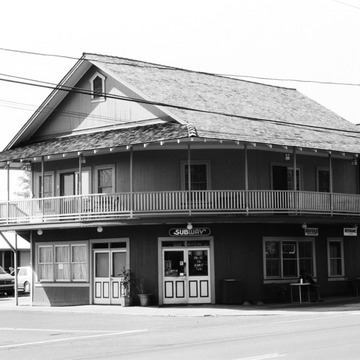Providing a distinctive and distinguished gateway for Moana Street, with their rounded corners, the Yamase building and its single-story echo, the Masuda building, are the products of Japanese master temple builder Jitsutaro Murakami. This itinerant carpenter worked on Kauai in the years immediately following World War I. The second-story verandah encircling the Yamase remains an impressive sight, audaciously supporting the gable roof's sheltering eave. The Masuda, with its parapet and encircling pent roofs, originally housed a grocery store and was constructed for Lee Kwai. The Yamase contained Sumitomo Bank and Yamase Tailor Shop, as well as accommodating the Yamase family upstairs. Waimea's first known electric streetlight was hung under the eaves of the Yamase building in 1921. Hurricane Iniki damaged the Yamase in 1992 and it was condemned. However, thanks to local preservation efforts, the building was saved and rehabilitated in 1995.
You are here
Yamase and Masuda Buildings
If SAH Archipedia has been useful to you, please consider supporting it.
SAH Archipedia tells the story of the United States through its buildings, landscapes, and cities. This freely available resource empowers the public with authoritative knowledge that deepens their understanding and appreciation of the built environment. But the Society of Architectural Historians, which created SAH Archipedia with University of Virginia Press, needs your support to maintain the high-caliber research, writing, photography, cartography, editing, design, and programming that make SAH Archipedia a trusted online resource available to all who value the history of place, heritage tourism, and learning.


